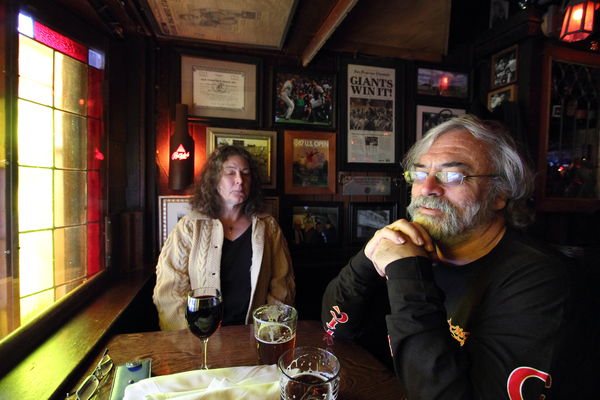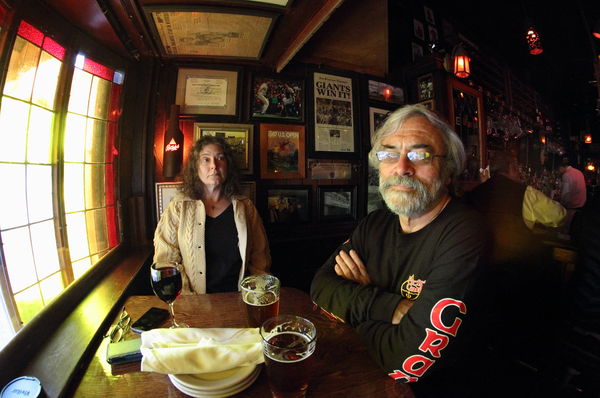Lensbaby v.s. Fisheye Lens
Dec 2, 2015 11:52:09 #
I STOP TO SHOOT
Loc: By the No. CA Sea
jayohwell wrote:
I have and frequently use a lensbaby fisheye, and like what Jim Quist posted. It is a fun lens and great in the right situation. I use it more often than I thought I would.
jayohwell: Thank you for the feed back.
Dec 2, 2015 12:03:50 #
I STOP TO SHOOT wrote:
Thank you Rich. Do you know if Dixiegirl has a web site with her photos? I guess I will have to wait until I see her on UHH to contact her. Appreciate the info. Thanks
If you go to the top and click on search and enter Dixiegirl you should get her and then you could send her a private message. She is always interest in helping. You can always tell here I sent you. Just mention bigwolf40 sent you..Rich
Dec 2, 2015 12:13:58 #
amfoto1
Loc: San Jose, Calif. USA
Both Lensbaby and fisheye are very specialized items, IMO.
There are actually a variety of products from Lensbaby, with different capabilities... but they basically are a crude form of tilt lens with lower quality optics, designed to give sort of an "interesting accident" effect. They are sort of the "Diana camera" of digital (Google those, if you don't know what they are). The "tiltable" nature of Lensbaby lets you play around with the plane of focus for "miniature" effects and other reasons... Many of them also sort of "celebrate" optical flaws, flare and other things we normally look for lenses to avoid.
Fisheye are another thing entirely, though equally unique in their own way. There are two type: those that make a round image and those that make a full, rectilinear image. Both types give extremely wide angle of view and often incredibly deep depth of field, possibly even sharpness all the way from your toes to a distant horizon. DoF can be so great with FE lenses that you might not even need to focus them!
But,unlike an ultrawide lens, a FE doesn't try to maintain straight lines in an image. So, there can be strong curvature effects with FE, that may or may not look "right", depending upon what you want in an image.
I don't currently have with either type of lens. I've used FE various times in the past... found them to be fun for a while and useful for humorous shots and in some very extreme situations (a friend who photographs a lot of aircraft frequently uses a rectilinear FE for shots inside cockpits and other tight interiors). But the strong "bending" effect makes them less usable for architectural interiors, on the whole... and of rather limited use for landscape, cityscape and seascape photos. They can be cool for sports/action shots...but you have to be awfully close or the subject will end up as just a very small speck within the image.
I have only briefly "messed around" with Lensbaby a couple times. I do use tilt-shift lenses for some similar, though generally more precisely controlled results with "better" image quality. I have enough photographic "accidents" of my own, without using a lens or camera that promotes them! :roll: But, hey, that's just me and I can certainly understand the appeal... Especially when so many people today pixel-peep at completely ridiculous magnifications and obsess over the slightest flaw in their "perfect" images.
There are actually a variety of products from Lensbaby, with different capabilities... but they basically are a crude form of tilt lens with lower quality optics, designed to give sort of an "interesting accident" effect. They are sort of the "Diana camera" of digital (Google those, if you don't know what they are). The "tiltable" nature of Lensbaby lets you play around with the plane of focus for "miniature" effects and other reasons... Many of them also sort of "celebrate" optical flaws, flare and other things we normally look for lenses to avoid.
Fisheye are another thing entirely, though equally unique in their own way. There are two type: those that make a round image and those that make a full, rectilinear image. Both types give extremely wide angle of view and often incredibly deep depth of field, possibly even sharpness all the way from your toes to a distant horizon. DoF can be so great with FE lenses that you might not even need to focus them!
But,unlike an ultrawide lens, a FE doesn't try to maintain straight lines in an image. So, there can be strong curvature effects with FE, that may or may not look "right", depending upon what you want in an image.
I don't currently have with either type of lens. I've used FE various times in the past... found them to be fun for a while and useful for humorous shots and in some very extreme situations (a friend who photographs a lot of aircraft frequently uses a rectilinear FE for shots inside cockpits and other tight interiors). But the strong "bending" effect makes them less usable for architectural interiors, on the whole... and of rather limited use for landscape, cityscape and seascape photos. They can be cool for sports/action shots...but you have to be awfully close or the subject will end up as just a very small speck within the image.
I have only briefly "messed around" with Lensbaby a couple times. I do use tilt-shift lenses for some similar, though generally more precisely controlled results with "better" image quality. I have enough photographic "accidents" of my own, without using a lens or camera that promotes them! :roll: But, hey, that's just me and I can certainly understand the appeal... Especially when so many people today pixel-peep at completely ridiculous magnifications and obsess over the slightest flaw in their "perfect" images.
Check out Underwater Photography Forum section of our forum.
Dec 2, 2015 13:03:52 #
amfoto1 wrote:
Both Lensbaby and fisheye are very specialized ite... (show quote)
I think Alan has made yet another mistake here, although I invite him to comment and correct me if I am wrong.
Fisheye lenses are distinctive in two ways. One is the extreme angle of view that they deliver and another is in the way the optics render images.
When referring to the shape of the image the stereotypical fisheye image is frequently a circular image against a black background, since the image created by the lens does not cover the entire area of the film or sensor.
However, this is not a characteristic of all fisheye lenses, and it is not the circular image that that defines whether a lens is a fisheye lens or not. The fisheye lens made by Samyang that several of us have referred to here is designed for APS-C cameras, and on an APS-C camera delivers a fisheye image that fills the entire frame. With the hood removed it will produce a circular image on a full frame camera from some of the reviews that I have read. I do not have the equipment to verify this personally. So if a single lens can produce both a circular image and full corner to corner coverage then it cannot simultaneously be two categories of fisheye lens, rather it is one fisheye lens being used on two different categories of camera that provides the difference between full coverage and a circular image. Any other type of lens that was designed for an APS-C sensor would also produce similar effects if mounted on a full frame camera.
So, that first point made, then what makes a fisheye lens a fisheye lens? It is the way that the lens optics render the scene. It is in this situation where Alan is completely and utterly wrong in his use of the term rectilinear.
A lens 'bends light rays' to create a focused image, which is frequently referred to as a 'projection'. The majority of lenses in use, whether ultra-wide or super-telephoto are designed to render straight lines as straight lines in the image. This is what is called a 'rectilinear' projection.
A fisheye lens uses a different projection method that renders straight lines differently, becoming increasingly curved towards the edges of the frame. This is frequently referred to as 'barrel distortion. It is this 'barrel distortion' projection that defines fisheye lenses, not corner to corner coverage as opposed to a circular image. Here is the wikipedia article on fisheye lenses: http://en.wikipedia.org/wiki/Fisheye_lens
Below I show two images ( not great photographs, just snaps taken in a pub), but demonstrating the difference between an ultra-wide rectilinear lens (Canon EF-S 10-22mm) and a fisheye lens (Samyang 8mm fisheye) on a T3i.
Frankly, I am very surprised at Alan's error in this matter. He has a record of presenting information as 'the ultimate authority' while making and repeating factual errors without once that I have seen responding to or acknowledging corrections to his mistakes and inaccurate information.
However, making simple mistakes in specifications is fairly trivial, and we all do that from time to time. In this case Alan has displayed a fundamental lack of understanding that is at least to my mind more egregious given his 'Voice of God' style of posting what are increasingly appearing to be his opinions rather than well researched and defensible factual statements. He sounds more like Donald Trump with every post!
Rectilinear projection - Canon EF-S 10 -22mm

Fisheye projection - Samyang 8mm

Dec 2, 2015 13:43:13 #
I STOP TO SHOOT wrote:
How many of you have now or are planning to use one of these lenses? How many of you have one currently? What is your opinion of such lenses? (Pros and Cons) Thank you for taking the time to comment.
I have a Rokinon fisheye that I use on my D7100 and have used with adapter on a Sony a6000. Not used frequently, but occasionally it has made some interesting pix. Also, with the Fisheye Hemi software, it becomes an extreme wideangle as the software straightens out the barrel.
Dec 2, 2015 17:52:43 #
I STOP TO SHOOT
Loc: By the No. CA Sea
bigwolf40 wrote:
If you go to the top and click on search and enter Dixiegirl you should get her and then you could send her a private message. She is always interest in helping. You can always tell here I sent you. Just mention bigwolf40 sent you..Rich
Thank you, I will do that
Dec 2, 2015 18:10:55 #
I STOP TO SHOOT
Loc: By the No. CA Sea
amfoto1 wrote:
Both Lensbaby and fisheye are very specialized ite... (show quote)
amfoto1: Thank you for your input, helps me to understand this a little better. I enjoy doing odd stuff at times when you might be shooting a lot of one sort.
Thanks
Check out Astronomical Photography Forum section of our forum.
Dec 2, 2015 18:26:11 #
I STOP TO SHOOT
Loc: By the No. CA Sea
Peterff wrote:
I think Alan has made yet another mistake here, al... (show quote)
Peterff:
Thank you for the multi information I will have to read it a couple times to digest it. I appreciate all the work you went through and I did check the web site on Fisheye lens it helps me to have this info to make a better decision.
Dec 2, 2015 18:28:34 #
I STOP TO SHOOT
Loc: By the No. CA Sea
Reinaldokool wrote:
I have a Rokinon fisheye that I use on my D7100 and have used with adapter on a Sony a6000. Not used frequently, but occasionally it has made some interesting pix. Also, with the Fisheye Hemi software, it becomes an extreme wideangle as the software straightens out the barrel.
Thank you for taking time to respond I will look at the Rokinon
Dec 2, 2015 20:17:14 #
There is a program (wish I could rember it's name) that takes fisheye images, un fisheyes them, and then creates an image you can scroll around in 360 degrees in all directions-- pretty neat
Stan
Stan
Dec 2, 2015 21:43:21 #
I have a couple of Lensbabies and the fisheye. They are not everyday lenses, but great fun when you feel like some creative photography. I probably only use then a couple of times a year, but they are always fun days. Take a class at PPSOP with Kathleen Clemens, she is the Lens Baby expert.
Check out Bridge Camera Show Case section of our forum.
Dec 3, 2015 06:51:31 #
stan0301 wrote:
There is a program (wish I could rember it's name) that takes fisheye images, un fisheyes them, and then creates an image you can scroll around in 360 degrees in all directions-- pretty neat
Stan
Stan
Are you thinking of a panorama stitcher? If so the one I know of is PTGui - there are others but I don't know the names.
360 panorama are most frequently made with fisheyes.
Dec 3, 2015 10:30:19 #
I STOP TO SHOOT
Loc: By the No. CA Sea
stan0301 wrote:
There is a program (wish I could rember it's name) that takes fisheye images, un fisheyes them, and then creates an image you can scroll around in 360 degrees in all directions-- pretty neat
Stan
Stan
stan0301: Thank you for the input makes it sound even more interesting. Appreciate your input
Dec 3, 2015 10:40:27 #
I STOP TO SHOOT
Loc: By the No. CA Sea
jolefont wrote:
I have a couple of Lensbabies and the fisheye. They are not everyday lenses, but great fun when you feel like some creative photography. I probably only use then a couple of times a year, but they are always fun days. Take a class at PPSOP with Kathleen Clemens, she is the Lens Baby expert.
jolefont: Well it seems like so few times for the price, but I will put it in my hope bucket will look in the class with Kathleen Clemens.
Thank you for taking the time to respond.
Dec 3, 2015 10:41:26 #
I STOP TO SHOOT
Loc: By the No. CA Sea
BboH wrote:
Are you thinking of a panorama stitcher? If so the one I know of is PTGui - there are others but I don't know the names.
360 panorama are most frequently made with fisheyes.
360 panorama are most frequently made with fisheyes.
BboH: Thank you for your input, will look into it...
If you want to reply, then register here. Registration is free and your account is created instantly, so you can post right away.
Check out Drone Video and Photography Forum section of our forum.





